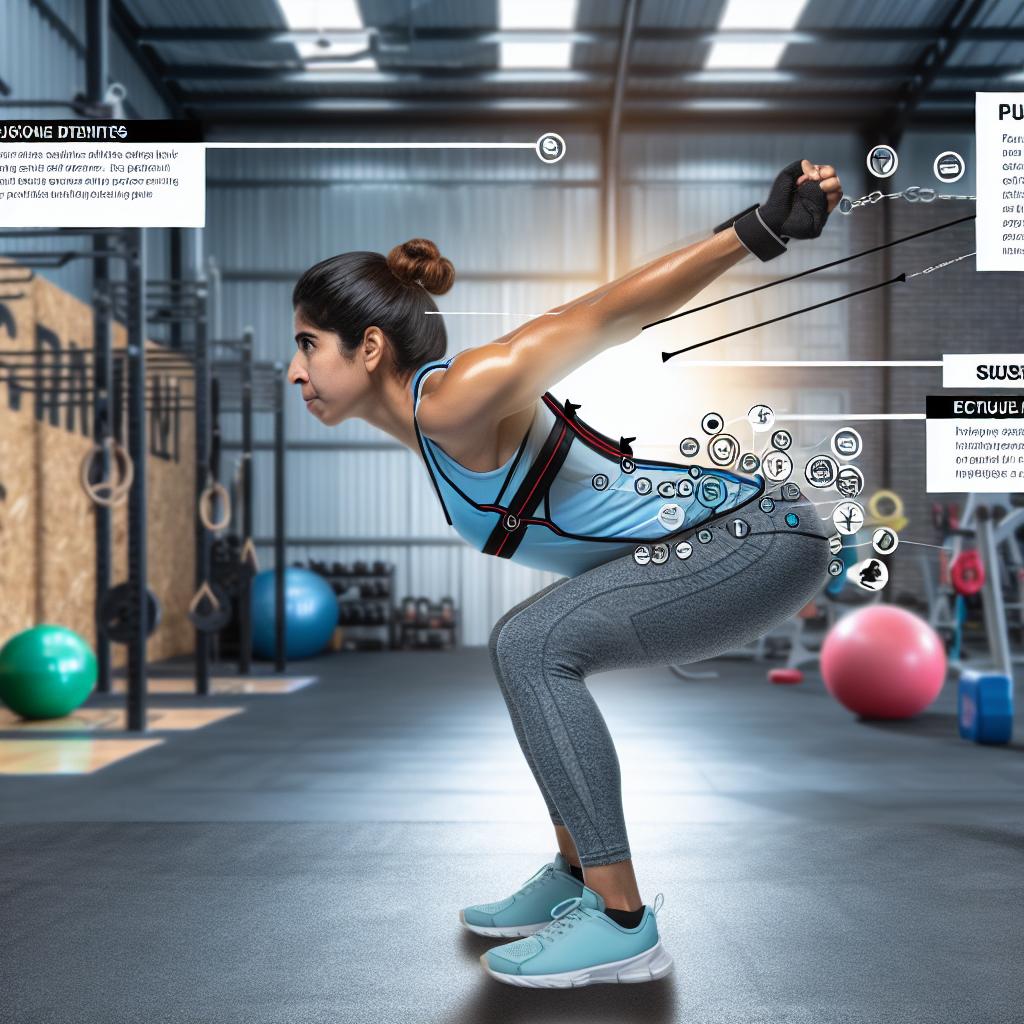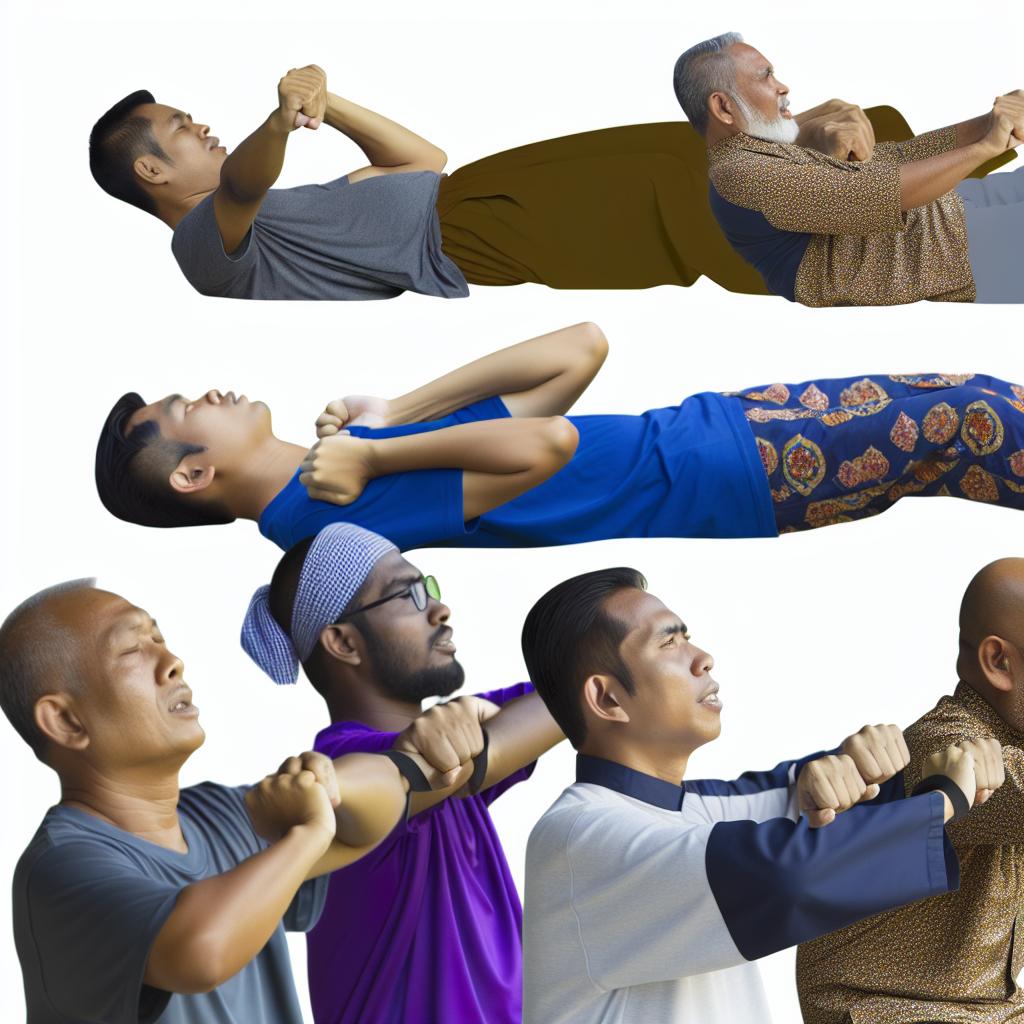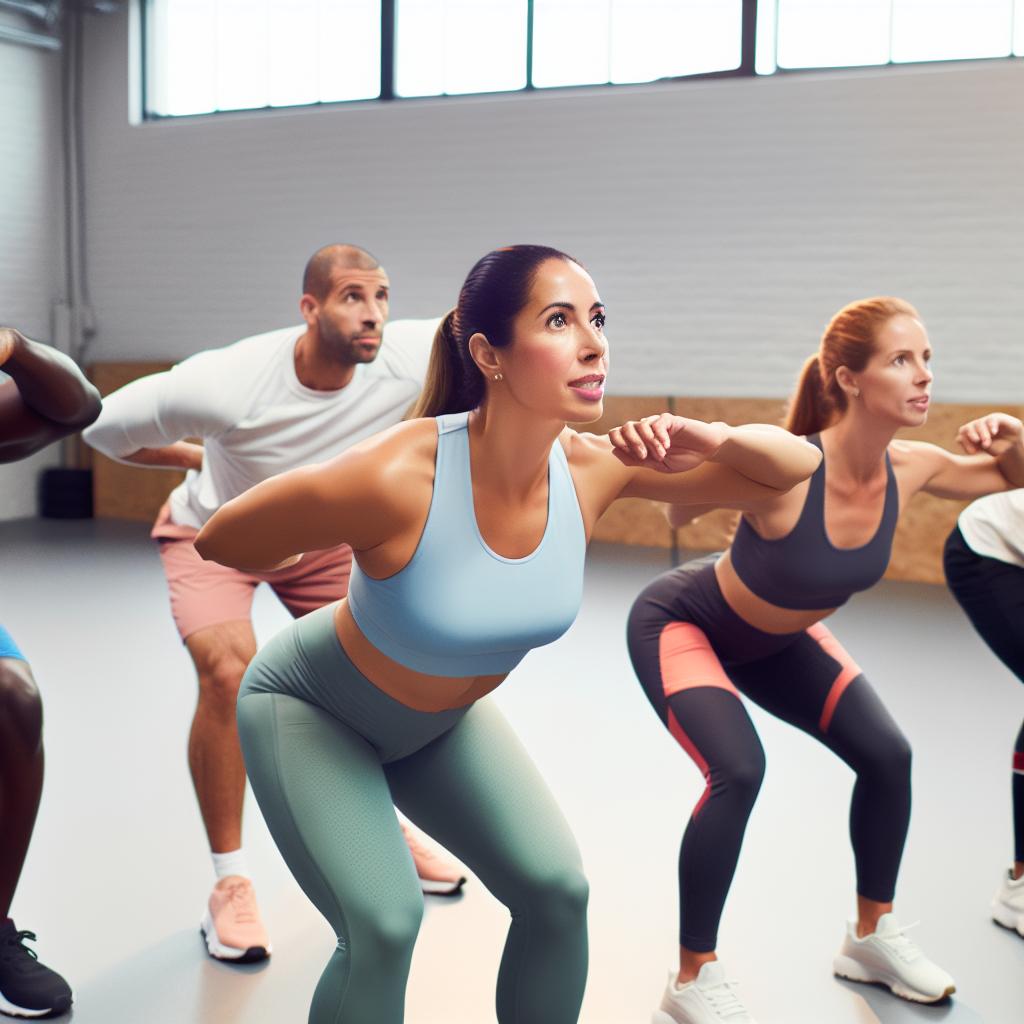Are face pulls primarily a back exercise, or do they target other muscle groups? this question is crucial for anyone looking to enhance their strength training routine. Understanding the benefits and proper technique of face pulls can optimize your workouts, improve posture, and bolster upper body stability, making it an essential addition to your training regimen.
## Understanding Face pulls: Are They Considered a Back Exercise?
The Role of Face Pulls in Back Training
Face pulls are a versatile exercise primarily targeting the upper back, especially the rear deltoids and the rhomboids.While frequently enough categorized as a shoulder exercise, their primary function is to enhance back strength and stability.Understanding their anatomy makes it clear that face pulls are indeed a form of back exercise, facilitating muscular balance and promoting good posture. By integrating them into your routine, you can strengthen the muscles that support the spine and improve overall back health.
Key benefits of Face Pulls
- Improved Posture: Face pulls help counteract the effects of prolonged sitting and poor posture by strengthening the upper back.
- Enhanced Shoulder Stability: Engaging in face pulls can enhance shoulder joint stability, which is crucial for overall shoulder health.
- Injury Prevention: Strengthening the upper back reduces the risk of shoulder injuries, especially in overhead activities.
Executing Face Pulls: Step-by-Step Guide
To maximize the effectiveness of face pulls, it’s essential to perform them correctly. Follow these steps for proper technique:
- equipment Setup: Attach a rope to a cable machine at upper chest height.
- Starting Position: Stand facing the machine, grasp the rope with both hands, palms facing each other, and take a few steps back to create tension.
- Execution: Pull the rope towards your face while keeping your elbows high and squeezing your shoulder blades together.
- control Movement: Slowly return to the starting position, maintaining tension on the cable.
- Repetitions: Aim for 2-3 sets of 12-15 reps, ensuring a controlled pace throughout.
Common Mistakes to Avoid
- Avoid flaring your elbows too far out; keep them at shoulder level.
- don’t use momentum; focus on a controlled pull and slow return.
- Ensure you’re not leaning back; maintain a neutral spine throughout the movement.
Incorporating Face Pulls into Your Routine
Face pulls can be included in various workout programs. Here are a few ways to incorporate them effectively:
- As a Warm-up: Use them to activate your upper back and rear shoulders before upper body workouts.
- During Upper Body Days: Include face pulls in your routine to balance pushing movements like bench presses.
- Post-Workout Stretch: Finish your sessions with face pulls to promote muscle recovery and relaxation.
| Exercise | Muscle Groups Targeted | Recommended Sets |
|---|---|---|
| Face Pulls | Upper Back, Rear Deltoids | 2-3 Sets of 12-15 Reps |
| bench Press | Chest, Triceps | 3-4 Sets of 8-10 Reps |
| Pull-ups | Latissimus Dorsi, Biceps | 3 Sets of 6-10 Reps |
## The Anatomy of Face Pulls: How They Target Your Back Muscles
The Mechanics of face Pulls
Face pulls are an remarkable exercise that specifically target the rear deltoids, upper back muscles, and rotator cuff. This movement is key for developing shoulder stability and overall upper body strength. By pulling a cable or resistance band towards your face, you engage various muscle groups in the back, promoting better posture and shoulder health.
Muscle Groups Engaged
- Rear Deltoids
- Rhomboids
- Trapezius
- Rotator Cuff Muscles
Proper Technique for Face Pulls
To maximize the benefits of face pulls, follow these step-by-step instructions:
- Attach a resistance band or cable at shoulder height.
- Stand facing the anchor point, with your feet shoulder-width apart.
- Grasp the handles with both hands using an overhand grip, palms facing each other.
- step back to create tension, and pull the band towards your face while keeping your elbows high.
- Squeeze your shoulder blades together at the peak of the movement.
- Slowly return to the starting position and repeat for the desired number of reps.
Common Mistakes to Avoid
- Allowing the elbows to drop too low.
- Using excessive weight that compromises form.
- rushing through the movement rather of focusing on the squeeze.
Benefits of Face Pulls
Incorporating face pulls into your routine not only strengthens the back muscles but also enhances overall athletic performance due to improved shoulder mechanics. Here are some compelling benefits:
| Benefit | Description |
|---|---|
| Improved Posture | Strengthens muscles responsible for maintaining proper spinal alignment. |
| Enhanced Shoulder Stability | Strengthens rotator cuff muscles, reducing injury risk. |
| Balance in Upper Body Progress | Counteracts the effects of forward-shoulder posture caused by pressing exercises. |
## Benefits of Face Pulls: improving Posture and Shoulder Health
Enhanced Postural Alignment
Face pulls are a fantastic exercise that targets the upper back and rear shoulders,helping to improve overall posture.By regularly incorporating face pulls into your workout routine, you can:
- Strengthen the upper back: Building muscle in the upper back counteracts the forward shoulder tilt that frequently enough results from prolonged sitting.
- Reduce slouching: Increasing strength in this area encourages a more upright posture.
- Balance muscle development: Engaging the rear deltoids and upper traps helps to balance the strength between the front and back shoulders.
Shoulder Health Improvement
In addition to enhancing posture, face pulls play a crucial role in maintaining shoulder health. Manny people suffer from shoulder pain due to muscle imbalances and poor movement patterns. Incorporating face pulls can yield the following benefits:
- Support rotator cuff function: Face pulls activate and strengthen the rotator cuff muscles, which are essential for shoulder stability.
- Prevent shoulder injuries: Strengthening the muscles around the shoulder can help reduce the risk of common injuries associated with overhead movements.
- Improve shoulder mobility: Regular practice of face pulls can enhance the flexibility of the shoulder joint, allowing for a greater range of motion during other exercises.
How to Perform Face Pulls
- Set up: Attach a rope handle to a cable machine at upper chest height.
- Grip: Stand with your feet shoulder-width apart and grasp the rope with both hands, palms facing each other.
- Position yourself: Step back to create tension in the cable, keeping your arms extended in front.
- Pull: Slowly pull the rope towards your face, flaring your elbows outwards. Squeeze your shoulder blades together at the peak of the movement.
- Return: Gradually extend your arms back to the starting position to complete the repetition.
quick Tips for Effective Face Pulls
| Tip | Benefit |
|---|---|
| Keep your elbows higher than your wrists | Encourages proper shoulder alignment. |
| Focus on squeezing your shoulder blades | Enhances muscle activation in the upper back. |
| Avoid using excessive weight | Ensures proper form and prevents injury. |
## Proper Technique for Face Pulls: Steps to maximize Effectiveness
Setting Up for Face Pulls
To begin effective face pulls, you’ll need a cable machine with a rope attachment or resistance bands anchored at upper chest height. Follow these steps:
- Adjust the weight on the cable machine, ensuring it’s appropriate for your strength level.
- Stand facing the machine, feet shoulder-width apart, with a slight bend in your knees.
- grab the rope with both hands, palms facing each other, stepping back until there is tension in the cable.
Executing the Face Pull
Once you’re set up, it’s time to execute the face pull. Pay careful attention to your form to maximize effectiveness:
- With your arms fully extended, pull the rope toward your face, keeping your elbows high and flared out.
- Squeeze your shoulder blades together at the peak of the movement, maintaining a neutral spine.
- Pause briefly before returning to the starting position, controlling the movement to avoid using momentum.
Key Form Tips
To ensure you’re executing the face pull correctly, keep these key points in mind:
- Maintain a straight back and tight core throughout the movement.
- Avoid shrugging your shoulders; focus on using your upper back muscles.
- Adjust the weight as needed to keep the tension effective without compromising form.
Incorporating Face Pulls into Your Routine
To achieve the best results, incorporate face pulls into your workout regimen effectively:
- Include face pulls in your upper-body workouts, aiming for 2-3 sets of 10-15 reps.
- Pair face pulls with other upper-back exercises, such as rows, for a balanced approach.
Benefits of Proper Technique
Focusing on proper technique when performing face pulls not only builds strength in the upper back but also enhances shoulder stability. Consistent practice can lead to:
- Improved posture by counteracting the effects of prolonged sitting.
- Reduction of shoulder injuries by strengthening the rotator cuff.
- Enhanced overall athletic performance,supporting various movements in sports and daily activities.
## Modifications and Variations: Tailoring Face Pulls to your Fitness Level
Modifications for beginners
For those new to face pulls, starting with lighter resistance is crucial for mastering the technique. Here are some modifications to build your strength and confidence:
- Resistance Bands: use lighter resistance bands that allow you to focus on form.
- Seated Face Pulls: Perform the exercise seated to reduce the strain on your lower back.
- Wall Support: Stand with your back against a wall to maintain proper posture and alignment.
Advanced Variations
As you progress, incorporating advanced variations can enhance the benefits of face pulls. Consider the following options:
- Single-Arm face Pulls: Perform the exercise one arm at a time to increase core engagement.
- Face pulls with External Rotation: Twist your wrists outward as you pull, which activates additional shoulder stabilizers.
- Face Pulls on a Stability Ball: This challenges your balance and core strength, adding an extra layer of difficulty.
Repetitions and sets
Beginners
Start with:
- 3 sets of 10-12 repetitions
- Focus on controlled movements and proper form
Intermediate to Advanced
For those more experienced:
- 4 sets of 12-15 repetitions
- Incorporate tempo variations, such as a 3-second hold at the peak contraction
Technique Tips
Regardless of your fitness level, pay attention to these technique tips for effective face pulls:
- Engage Your Core: Keep your abdominal muscles tight to stabilize your posture.
- Maintain Neutral Shoulders: Avoid shrugging your shoulders; keep them down and relaxed.
- Control the Movement: Prioritize slow, intentional pulls to maximize muscle engagement and reduce injury risk.
## Addressing Common Challenges: Overcoming Issues with Face pulls
identifying Common Issues
Face pulls are a fantastic exercise for improving shoulder health and upper back strength, but several challenges can hinder their effectiveness. Common issues include:
- improper Form: lifting the weights incorrectly can lead to unnecessary strain and even injury.
- Insufficient Range of Motion: Many individuals struggle to fully engage the targeted muscles due to limited movement.
- Weakness in Key Muscles: A lack of strength in the rear deltoids or rotator cuff can compromise technique.
Correcting Technique issues
Improving your face pull technique is crucial to reaping the full benefits.Follow these steps:
- Set Up: attach the rope to a cable machine at upper chest level. Stand facing the machine with feet shoulder-width apart.
- Grip: Grab the ends of the rope with an overhand grip, stepping back until there’s tension in the cable.
- Posture: Maintain a straight back and engaged core throughout the movement.
- Execution: Pull the rope towards your face while keeping your elbows high. Squeeze your shoulder blades together at the peak.
- Return: Slowly extend your arms back to the starting position to maintain tension on the muscles.
Enhancing range of Motion
If you’re struggling with range of motion, consider these helpful tips:
- Warm-Up: Incorporate dynamic stretches focusing on the shoulders and upper back before your workout.
- Use Lighter Weights: Start with lighter weights to practice and perfect your form.
- Incorporate Mobility Work: Adding exercises like band pull-aparts and shoulder dislocates can improve flexibility.
Example Mobility Routine
| Exercise | Reps | Sets |
|---|---|---|
| Band pull-Aparts | 15 | 3 |
| Shoulder Dislocates | 10 | 2 |
| arm Circles | 30 seconds | 2 |
## Incorporating Face Pulls into Your Routine: Practical Tips for Success
Understanding Face Pulls
Face pulls are an effective exercise primarily targeting the upper back, particularly the rear deltoids, upper traps, and external rotators of the shoulder. Incorporating face pulls into your fitness routine can enhance shoulder stability, improve posture, and counteract the effects of prolonged sitting or poor posture.
How to Execute Face Pulls Correctly
To reap the maximum benefits of face pulls, it’s crucial to perform them with proper technique:
- **Equipment**: Use a cable machine with a rope attachment, or resistance bands anchored at upper chest height.
- **Setup**: Stand facing the cable machine or anchor point,holding the rope or band with both hands.
- **Positioning**: Step back to create tension, keeping your feet shoulder-width apart while engaging your core.
- **Execution**: Pull the rope or band towards your face, keeping your elbows high and squeezing the shoulder blades together.
- **Finishing**: Hold the contraction for a moment before slowly returning to the starting position. Aim for 2-3 sets of 10-15 reps.
Common Mistakes to Avoid
To ensure optimal results and prevent injury,be mindful of these common mistakes:
- **Arching the Back**: Maintain a neutral spine; avoid leaning back excessively.
- **Protracting Shoulders**: Keep shoulders relaxed and down; don’t let them shrug up towards your ears.
- **Poor Movement Speed**: Focus on a controlled tempo throughout each rep, especially during the eccentric phase.
Integrating face Pulls into Your Weekly Routine
Consider these practical tips for incorporating face pulls effectively:
- **Frequency**: Perform face pulls 2-3 times per week as part of your upper body or shoulder workout.
- **Pairing**: combine face pulls with pushing movements (like bench presses) to maintain balance in your workout.
- **Variations**: Experiment with different angles and grips to target various areas of the shoulders and upper back.
Sample Weekly Routine
| Day | Workout Focus | Face Pulls |
|---|---|---|
| Monday | Upper Body | 3 sets of 12 reps |
| Wednesday | Lower Body | Rest |
| Friday | Full Body | 2 sets of 15 reps |
## complementary Exercises: Enhancing Your Back Workout with Face Pulls
Understanding Face Pulls
Face pulls are often categorized as a vital **complementary exercise** that can effectively enhance your back workout. This exercise primarily targets the **upper back, shoulders,** and **rotator cuffs**, contributing to improved posture and shoulder stability. By incorporating face pulls into your routine, you can offset the effects of dominant pushing movements, ensuring a balanced and well-developed musculature.
Benefits of Face Pulls
- Improved Posture: Strengthening the upper back can help counteract poor posture resulting from prolonged sitting.
- Injury Prevention: Strengthening the rotator cuffs adds stability to the shoulder joint,reducing the likelihood of injuries.
- Muscle Activation: Face pulls effectively recruit the posterior deltoids and rhomboids, promoting balanced muscle development.
Step-by-step Guide to performing Face Pulls
- Attach a rope handle to a cable pulley at chest height.
- Stand facing the pulley with your feet shoulder-width apart.
- Grab the ends of the rope with both hands, palms facing each other.
- Step back slightly to tension the cable, keeping your arms extended.
- Pull the rope towards your face, ensuring your elbows are high and your upper arms are parallel to the ground.
- Focus on squeezing your shoulder blades together at the peak of the movement.
- Slowly return to the starting position while maintaining control.
Integrating Face pulls into Your Routine
To maximize the effectiveness of face pulls, consider these integration tips:
- Frequency: Aim to include face pulls in your workout 2-3 times a week.
- Repetitions: Perform 3 sets of 12-15 repetitions, adjusting weight for optimal form.
- Warm-up: Always incorporate dynamic stretches targeting the shoulders and upper back before executing face pulls.
Sample Back Workout Including Face Pulls
| Exercise | Sets | Reps |
|---|---|---|
| Deadlifts | 3 | 8-10 |
| Pull-Ups | 3 | 6-8 |
| Face Pulls | 3 | 12-15 |
| Bent Over Rows | 3 | 10-12 |
## Stretching and Recovery: Supporting Your Body After Face Pulls
Importance of Stretching Post Face Pulls
After completing face pulls, it’s crucial to incorporate stretching and recovery exercises to help prevent muscle tightness and promote overall flexibility. Ensuring proper recovery supports your body, allowing it to adapt and grow stronger. Here are some effective stretches to include:
- Neck Stretch: Gently tilt your head to one side and hold for 15-20 seconds, then switch sides.
- Chest Opener: Stand tall and clasp your hands behind your back, straightening your arms to stretch your chest. Hold for 20-30 seconds.
- Shoulder Stretch: Bring one arm across your chest and hold it with the opposite hand to stretch the shoulder. Hold for 15-20 seconds and switch sides.
Recovery techniques to Enhance Results
In addition to stretching, players can benefit from targeted recovery techniques that further assist in muscle repair and flexibility. Incorporating these methods can lead to better performance and reduced risk of injury:
Foam rolling
Use a foam roller to relieve muscle tightness by rolling out the upper back,shoulders,and neck. Aim for:
- 30-60 seconds per area
- Gentle pressure; adjust based on comfort
Hydration and Nutrition
Proper hydration and nutrition are essential for recovery. Focus on:
- Consuming protein-rich foods post-exercise for muscle repair.
- staying hydrated to support overall bodily functions.
Sample Recovery Routine
| Exercise | Duration |
|---|---|
| Neck Stretch | 15-20 seconds per side |
| Chest Opener | 20-30 seconds |
| shoulder Stretch | 15-20 seconds per side |
| Foam Rolling | 30-60 seconds per area |
| Hydration | As needed |

Frequently asked questions
### Are Face Pulls Primarily a Back Exercise?
Face pulls are frequently enough categorized as a back exercise as they primarily target the muscles in the upper back, specifically the rear deltoids, rhomboids, and lower traps. These muscles play a crucial role in maintaining proper posture and shoulder health. When you perform face pulls, you’re engaging these muscles to pull the resistance towards your face, which facilitates muscle activation in the upper back region.
However, face pulls also engage the rotator cuff muscles, which are essential for shoulder stability and health. While the focus remains on the back, the shoulder and upper back muscles work together during this exercise. It’s crucial to recognize that face pulls also contribute to a well-rounded upper body workout and can be beneficial for anyone aiming to improve their strength and functionality in these areas.### What Are the Key Benefits of Face Pulls?
Face pulls offer numerous benefits that go beyond just building strength in the back. Here are some primary advantages:
– **Improves Posture**: By strengthening the upper back and shoulders,face pulls help counteract the forward slouch caused by prolonged sitting and activities like desk work.- **Enhances Shoulder Health**: Regular incorporation of face pulls can enhance the stability of the shoulder joint, reducing the risk of injuries and improving overall function in various activities.- **Balances Muscle Development**: Many individuals focus predominantly on pressing movements (like bench presses), which may lead to muscle imbalances. face pulls help to achieve balanced muscular development across the shoulder girdles.
Incorporating face pulls into your routine can help set the foundation for a stronger,healthier upper body. It’s beneficial not only for those involved in strength training but also for athletes and individuals looking to improve their physical conditioning.
### How Should You Perform Face Pulls?
To effectively perform face pulls, follow these step-by-step instructions:
1.**Equipment Setup**: Use a cable machine with a rope attachment set at upper chest height. Ensure the weight is appropriate for your fitness level.
2. **Starting Position**:
- Stand facing the cable machine.
– Grip the rope with both hands using an overhand grip, palms facing each other. Your elbows should be slightly bent.
3.**Execution**:
– Step back until there is tension in the cable.
– Pull the rope towards your face, keeping your elbows high and flaring out away from your body.
– Squeeze your shoulder blades together as you pull, focusing on using your upper back muscles.
4. **Return**: Slowly extend your arms back to the starting position, maintaining control throughout the movement.
Aim for **2-3 sets of 10-15 repetitions**. Remember to maintain a neutral spine and avoid rounding your shoulders. Focusing on form will maximize the effectiveness of the exercise.
### What Common Mistakes Should I Avoid While Doing Face Pulls?
When performing face pulls, it’s essential to avoid certain common pitfalls that can hinder your progress or even lead to injury:
– **Using Too Much Weight**: It’s tempting to load the machine excessively, but lifting too heavy can compromise your form.Prioritize technique over weight to effectively target the appropriate muscles.Start light and gradually increase resistance as your form improves.
– **Rounding the Shoulders**: ensure that you keep your shoulders back and avoid rounding them forward during the pull.Proper alignment not only enhances effectiveness but also protects against injury.
– **Jerky Movements**: Focus on a controlled movement pattern throughout the exercise. Avoid using momentum to complete the pull, as this can distract from the targeted muscle engagement.
By being mindful of these mistakes, you can maximize the benefits of face pulls while safely developing strength in your upper back.
### How Frequently enough Should you Include Face Pulls in Your Workout Routine?
The frequency of face pulls in your workout regimen can vary based on your fitness goals and overall program structure. Generally, performing face pulls **2-3 times per week** is recommended for most individuals. consider these guidelines when planning your workouts:
– **Integration into Push/Pull Regimens**: If you follow a push/pull workout split, consider adding face pulls to your pull days, focusing on back and bicep exercises.
– **Dynamic Warm-Up**: Including face pulls as part of your dynamic warm-up can prepare your shoulders and back for heavier lifts later in the session. This can help improve performance and reduce the risk of injury.- **Rehabilitation or Prehab Programs**: If you’re focusing on shoulder rehabilitation or injury prevention, incorporating face pulls 3-4 times a week may be beneficial to promote muscle balance and stability.
Listening to your body is crucial. If you experience discomfort or fatigue, adjust the frequency and intensity accordingly to suit your individual needs.
### Can I Do Face Pulls at Home Without Equipment?
Yes,you can perform adaptations of face pulls at home,even without access to gym equipment. Here are a couple of options you can try:
– **Resistance Bands**: Attach a resistance band around a sturdy anchor point at eye level (like a doorframe). Grip the ends and perform face pulls by following the same technique described earlier.
– **Towel or Fasteners**: If you don’t have any bands, hold a towel with both hands, keeping it taut. Pull the towel towards your face while maintaining the right posture.This method can still engage your upper back if done with proper form.Always ensure your makeshift setup is secure to avoid injuries.No matter where you are or what equipment you have, you can perform variations of face pulls to maintain your training consistency.
In Retrospect
## Conclusion: Incorporating Face Pulls into Your Routine
Face pulls are not just another exercise; they are a valuable component of back training that can significantly enhance your strength and posture. By understanding the benefits and perfecting your technique, you can easily integrate face pulls into your workout regimen.### Key Takeaways
– **Focus on Form:** Proper technique is crucial for maximizing benefits and preventing injury.
– **Strengthen Your Back:** Face pulls target the upper back, improving muscle balance and posture.
- **Enhance Overall Fitness:** These can improve shoulder stability and aid in injury prevention.
### Next steps
1. **Set Up Your Equipment:**
- Use either a cable machine or resistance bands at shoulder height.
2. **Practice the Technique:**
– Start with light weights to master the movement before progressing.
3. **Incorporate into Your Workouts:**
– Aim for 2-3 sets of 10-15 reps, 2-3 times per week.
### Remember:
Consistency is key! Integrate face pulls into your routine, and over time, you’ll witness improvements in your back strength and overall performance.
You’ve got this! Take the first step today, and enjoy the journey to a stronger, healthier you. Happy training!










